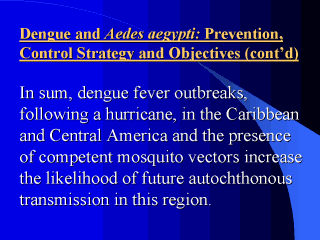 |
A laboratory-based active surveillance
program can detect cases of dengue involving all four dengue serotypes. An active
surveillance program can demonstrate that dengue infections are occurring at a much higher
rate than reflected by previous passive surveillance programs and this in turn
demonstrates that the risk for local dengue transmission may be increasing. Furthermore,
satellite imagery analysis provides an efficient survey of large geographic regions for
environmental indicators of disease risk affecting human populations and has the potential
to make an effective surveillance of disease risk for vector-borne diseases practical for
public health applications. The basis for the supposition that remotely sensed data will
be useful for anticipating disease risk is that pathogen transmission is facilitated by
arthropods, whose survival and reproduction are influenced by variations in elevation,
temperature and humidity. |
